Does Culture Shape Our Spatial Ability? An Investigation Based on Eye Tracking
Abstract
1. Introduction
2. Related Work
2.1. Spatial Ability and the Effect of Culture
2.2. Eye Tracking to Evaluate Spatial Ability
3. Methods
3.1. Participants
3.2. Apparatus
3.3. Materials and Procedure
3.4. Data Analysis
4. Results
4.1. Mental Rotation
4.2. Spatial Visualization
4.3. Spatial Orientation
4.4. Spatial Correlation
5. Discussion
5.1. Similarities in Two Cultural Groups: Overall Performance and Visual Information Processing
5.2. Differences in Two Cultural Groups: Accuracy of Small-Scale and Visual Attention Allocation of Large-Scale
6. Conclusions and Future Work
Author Contributions
Funding
Institutional Review Board Statement
Informed Consent Statement
Data Availability Statement
Acknowledgments
Conflicts of Interest
Appendix A
| Eye Movement Index | Effect | 95% Confidence Interval | |||
|---|---|---|---|---|---|
| EST | SE | F | p Value | ||
| Fixation count/# | CB | −5.621 | 7.163 | 0.616 | 0.437 |
| Intercept | 62.814 | 3.869 | |||
| Fixation duration/s | CB | −1.766 | 1.733 | 1.039 | 0.314 |
| Intercept | 15.142 | 0.936 | |||
| Saccade count/# | CB | −9.280 | 9.828 | 0.892 | 0.350 |
| Intercept | 93.531 | 5.429 | |||
| Saccade frequency/#·s−1 | CB | 0.591 | 0.507 | 1.360 | 0.250 |
| Intercept | 4.275 | 0.280 | |||
| Eye Movement Index | Effect | 95% Confidence Interval | |||
|---|---|---|---|---|---|
| Coefficient | SE | F | p Value | ||
| Time to first fixation/s | CB | −0.010 | 0.022 | 0.194 | 0.663 |
| Intercept | 0.320 | 0.014 | |||
| Ratio of fixation count/# | CB | 0.011 | 0.018 | 0.343 | 0.562 |
| Intercept | 0.701 | 0.011 | |||
| Ratio of fixation duration/s | CB | 0.016 | 0.020 | 0.628 | 0.433 |
| Intercept | 0.734 | 0.012 | |||
| Saccade count/# | CB | −2.252 | 11.168 | 0.041 | 0.841 |
| Intercept | 97.503 | 6.888 | |||
| Saccade frequency/#·s−1 | CB | 0.482 | 0.440 | 1.200 | 0.281 |
| Intercept | 3.895 | 0.272 | |||
| Eye Movement Index | Effect | 95% Confidence Interval | ||||
|---|---|---|---|---|---|---|
| EST | SE | F | p Value | |||
| Ratio of fixation count | Road | CB | 0.021 | 0.049 | 0.180 | 0.674 |
| Intercept | 0.214 | 0.169 | ||||
| Building | CB | −0.009 | 0.046 | 0.038 | 0.846 | |
| Intercept | 0.583 | 0.027 | ||||
| Landmark | CB | −0.023 | 0.009 | 6.123 | 0.019 * | |
| Intercept | 0.091 | 0.006 | ||||
| Intersection | CB | 0.003 | 0.006 | 0.148 | 0.702 | |
| Intercept | 0.042 | 0.004 | ||||
| Ratio of fixation duration | Road | CB | 0.022 | 0.053 | 0.179 | 0.674 |
| Intercept | 0.222 | 0.031 | ||||
| Building | CB | −0.010 | 0.050 | 0.037 | 0.849 | |
| Intercept | 0.570 | 0.029 | ||||
| Landmark | CB | −0.020 | 0.009 | 4.908 | 0.034 * | |
| Intercept | 0.080 | 0.005 | ||||
| Intersection | CB | 0.004 | 0.008 | 0.243 | 0.625 | |
| Intercept | 0.046 | 0.005 | ||||
| Saccade count/# | CB | −2.665 | 5.155 | 0.267 | 0.608 | |
| Intercept | 52.335 | 3.010 | ||||
| Saccade frequency/#·s−1 | CB | 0.525 | 0.433 | 1.471 | 0.233 | |
| Intercept | 4.745 | 0.309 | ||||
| Eye Movement Index | Effect | 95% Confidence Interval | ||||
|---|---|---|---|---|---|---|
| EST | SE | F | p Value | |||
| Ratio of fixation count | Title | CB | 0.035 | 0.199 | 3.096 | 0.085 |
| Intercept | 0.118 | 0.011 | ||||
| Legend | CB | 0.002 | 0.018 | 0.011 | 0.919 | |
| Intercept | 0.205 | 0.009 | ||||
| Main map | CB | −0.054 | 0.028 | 3.655 | 0.062 | |
| Intercept | 0.520 | 0.017 | ||||
| Ratio of fixation duration | Title | CB | 0.025 | 0.018 | 1.923 | 0.172 |
| Intercept | 0.070 | 0.010 | ||||
| Legend | CB | 0.000 | 0.020 | 0.000 | 0.996 | |
| Intercept | 0.217 | 0.011 | ||||
| Main map | CB | −0.070 | 0.031 | 4.951 | 0.031 * | |
| Intercept | 0.524 | 0.017 | ||||
| Saccade count/# | CB | 30.782 | 19.839 | 2.408 | 0.129 | |
| Intercept | 148.822 | 10.502 | ||||
| Saccade frequency/#·s- | CB | −0.071 | 0.301 | 0.055 | 0.815 | |
| Intercept | 4.734 | 0.159 | ||||
| Switch time/# | CB | −0.784 | 2.392 | 0.107 | 0.745 | |
| Intercept | 22.485 | 1.300 | ||||
| Switch frequency/#·s−1 | CB | −0.116 | 0.043 | 7.199 | 0.010 ** | |
| Intercept | 0.703 | 0.025 | ||||
References
- Golledge, R.G.; Jacobson, R.D.; Kitchin, R.; Blades, M. Cognitive Maps, Spatial Abilities, and Human Wayfinding. Geogr. Rev. Jpn. Ser. B 2000, 73, 93–104. [Google Scholar] [CrossRef]
- Stieff, M.; Uttal, D. How Much Can Spatial Training Improve STEM Achievement? Educ. Psychol. Rev. 2015, 27, 607–615. [Google Scholar] [CrossRef]
- Bolen, J.A. Spatial Ability, Motivation, and Attitude of Students as Related to Science Achievement. Ph.D. Thesis, University of north Texas, Denton, TX, USA, 2011. [Google Scholar]
- Jiang, W. The Relationship between Culture and Language. ELT J. 2000, 54, 328–334. [Google Scholar] [CrossRef]
- Peng, K.; Knowles, E.D. Culture, Education, and the Attribution of Physical Causality. Personal. Soc. Psychol. Bull. 2003, 29, 1272–1284. [Google Scholar] [CrossRef] [PubMed]
- Edensor, T. National Identity, Popular Culture and Everyday Life; Routledge: New York, NY, USA; London, UK, 2020. [Google Scholar]
- Kerrigan, L.; Thomas, M.S.C.; Bright, P.; Filippi, R. Evidence of an Advantage in Visuo-Spatial Memory for Bilingual Compared to Monolingual Speakers. Biling. Lang. Cogn. 2016, 20, 602–612. [Google Scholar] [CrossRef]
- Fuhrman, O.; Boroditsky, L. Cross-Cultural Differences in Mental Representations of Time: Evidence From an Implicit Nonlinguistic Task. Cogn. Sci. 2010, 34, 1430–1451. [Google Scholar] [CrossRef]
- Goeke, C.; Kornpetpanee, S.; Köster, M.; Fernández-Revelles, A.B.; Gramann, K.; König, P. Cultural Background Shapes Spatial Reference Frame Proclivity. Sci. Rep. 2015, 5, 11426. [Google Scholar] [CrossRef]
- Coutrot, A.; Silva, R.; Manley, E.; de Cothi, W.; Sami, S.; Bohbot, V.D.; Wiener, J.M.; Hölscher, C.; Dalton, R.C.; Hornberger, M.; et al. Global Determinants of Navigation Ability. Curr. Biol. 2018, 28, 2861–2866.e4. [Google Scholar] [CrossRef]
- Chang, K.; Antes, J.R. Sex and Cultural Differences in Map Reading. Am. Cartogr. 1987, 14, 29–42. [Google Scholar] [CrossRef]
- Davies, C.; Pederson, E. Grid Patterns and Cultural Expectations in Urban Wayfinding. In Spatial Information Theory; Lecture Notes in Computer Science; Springer: Berlin, Heidelberg, 2001; pp. 400–414. [Google Scholar]
- Demetriou, A.; Kui, Z.X.; Spanoudis, G.; Christou, C.; Kyriakides, L.; Platsidou, M. The Architecture, Dynamics, and Development of Mental Processing: Greek, Chinese, or Universal? Intelligence 2005, 33, 109–141. [Google Scholar] [CrossRef]
- Tan, C.B.Y.; Stephen, I.D.; Whitehead, R.; Sheppard, E. You Look Familiar: How Malaysian Chinese Recognize Faces. PLoS ONE 2012, 7, e29714. [Google Scholar] [CrossRef] [PubMed]
- Lohman, D.F. Spatial Ability: A Review and Reanalysis of the Correlational Literature; School of Education, Stanford University: Stanford, CA, USA, 1979. [Google Scholar]
- Linn, M.C.; Petersen, A.C. Emergence and Characterization of Sex Differences in Spatial Ability: A Meta-Analysis. Child Dev. 1985, 56, 1479–1498. [Google Scholar] [CrossRef] [PubMed]
- McGee, M.G. Human Spatial Abilities: Psychometric Studies and Environmental, Genetic, Hormonal, and Neurological Influences. Psychol. Bull. 1979, 86, 889–918. [Google Scholar] [CrossRef]
- Lohman, D. Spatial Ability and G. Hum. Abil. Nat. Meas. 1996, 97, 1. [Google Scholar]
- Buckley, J.; Seery, N.; Canty, D. A Heuristic Framework of Spatial Ability: A Review and Synthesis of Spatial Factor Literature to Support Its Translation into STEM Education. Educ. Psychol. Rev. 2018, 30, 947–972. [Google Scholar] [CrossRef]
- Guilford, J.P.; Lacey, J.I. Printed Classification Tests; US Government Printing Office: Washington, DC, USA, 1947.
- Guay, R.B. Purdue Spatial Visualization Test; Purdue Research Foundation: West Lafayette, IN, USA, 1976. [Google Scholar]
- Vandenberg, S.G.; Kuse, A.R. Mental Rotations, a Group Test of Three-Dimensional Spatial Visualization. Percept. Mot. Ski. 1978, 47, 599–604. [Google Scholar] [CrossRef] [PubMed]
- Bednarz, R.; Lee, J. What Improves Spatial Thinking? Evidence from the Spatial Thinking Abilities Test. Int. Res. Geogr. Environ. Educ. 2019, 28, 262–280. [Google Scholar] [CrossRef]
- Farrell, S.; Duffy, G.; Bowe, B. A Cross-Cultural Exploration of Spatial Visualisation Abilities of First Year STEM Students: Students from Gulf States and Ireland. In Proceedings of the 2015 International Conference on Interactive Collaborative Learning (ICL), Firenze, Italy, 20–24 September 2015; pp. 922–926. [Google Scholar]
- Seng, A.S.H.; Tan, L.C. Cultural and Gender Differences in Spatial Ability of Young Children. In Proceedings of the ACEI 2002 Annual Conference, Paris, France, 1 July 2002. [Google Scholar]
- Parameswaran, G. Experimenter Instructions as a Mediator in the Effects of Culture on Mapping One’s Neighborhood. J. Environ. Psychol. 2003, 23, 409–417. [Google Scholar] [CrossRef]
- Berry, J.W. Temne and Eskimo Perceptual Skills. Int. J. Psychol. 1966, 1, 207–229. [Google Scholar] [CrossRef]
- Gabriel, S.P. ‘After the Break’: Re-Conceptualizing Ethnicity, National Identity and ‘Malaysian-Chinese’ Identities. Ethn. Racial Stud. 2013, 37, 1211–1224. [Google Scholar] [CrossRef]
- Kiefer, P.; Giannopoulos, I.; Raubal, M. Where Am I? Investigating Map Matching During Self-Localization with Mobile Eye Tracking in an Urban Environment. Trans. GIS 2014, 18, 660–686. [Google Scholar] [CrossRef]
- Davis, R. The Feasibility of Using Virtual Reality and Eye Tracking in Research with Older Adults with and Without Alzheimer’s Disease. Front. Aging Neurosci. 2021, 13, 607219. [Google Scholar] [CrossRef] [PubMed]
- Dong, W.; Liao, H.; Zhan, Z.; Liu, B.; Wang, S.; Yang, T. New Research Progress of Eye Tracking-Based Map Cognition in Cartography since 2008. Acta Geogr. Sin. 2019, 74, 599–614. [Google Scholar]
- Liao, H.; Dong, W.; Peng, C.; Liu, H. Exploring Differences of Visual Attention in Pedestrian Navigation When Using 2D Maps and 3D Geo-Browsers. Cartogr. Geogr. Inf. Sci. 2017, 44, 474–490. [Google Scholar] [CrossRef]
- Cazzato, V.; Basso, D.; Cutini, S.; Bisiacchi, P. Gender Differences in Visuospatial Planning: An Eye Movements Study. Behav. Brain Res. 2010, 206, 177–183. [Google Scholar] [CrossRef]
- Andersen, N.E.; Dahmani, L.; Konishi, K.; Bohbot, V.D. Eye Tracking, Strategies, and Sex Differences in Virtual Navigation. Neurobiol. Learn. Mem. 2012, 97, 81–89. [Google Scholar] [CrossRef]
- Toth, A.J.; Campbell, M.J. Investigating Sex Differences, Cognitive Effort, Strategy, and Performance on a Computerised Version of the Mental Rotations Test via Eye Tracking. Sci. Rep. 2019, 9, 19430. [Google Scholar] [CrossRef]
- Sun, Y.; Lu, X.; Wang, Y. Using Eye Tracking to Explore Differences between High and Low Map-Based Spatial Ability. J. Geogr. 2020, 119, 215–225. [Google Scholar] [CrossRef]
- Dong, W.; Ying, Q.; Yang, Y.; Tang, S.; Zhan, Z.; Liu, B.; Meng, L. Using Eye Tracking to Explore the Impacts of Geography Courses on Map-Based Spatial Ability. Sustainability 2018, 11, 76. [Google Scholar] [CrossRef]
- Dong, W.; Zhan, Z.; Liao, H.; Meng, L.; Liu, J. Assessing Similarities and Differences between Males and Females in Visual Behaviors in Spatial Orientation Tasks. ISPRS Int. J. Geo-Inf. 2020, 9, 115. [Google Scholar] [CrossRef]
- Šašinka, Č.; Stachoň, Z.; Čeněk, J.; Šašinková, A.; Popelka, S.; Ugwitz, P.; Lacko, D. A Comparison of the Performance on Extrinsic and Intrinsic Cartographic Visualizations through Correctness, Response Time and Cognitive Processing. PLoS ONE 2021, 16, e0250164. [Google Scholar] [CrossRef] [PubMed]
- Liao, H.; Dong, W. An Exploratory Study Investigating Gender Effects on Using 3D Maps for Spatial Orientation in Wayfinding. ISPRS Int. J. Geo-Inf. 2017, 6, 60. [Google Scholar] [CrossRef]
- Popelka, S. Eye-Tracking Evaluation of 3D Thematic Maps. In Proceedings of the 3rd Workshop on Eye Tracking and Visualization, Warsaw, Poland, 15 June 2018; pp. 1–5. [Google Scholar]
- Çöltekin, A.; Brychtová, A.; Griffin, A.L.; Robinson, A.C.; Imhof, M.; Pettit, C. Perceptual Complexity of Soil-Landscape Maps: A User Evaluation of Color Organization in Legend Designs Using Eye Tracking. Int. J. Digit. Earth 2017, 10, 560–581. [Google Scholar] [CrossRef]
- Hesselmann, G. Applying Linear Mixed Effects Models (LMMs) in Within-Participant Designs With Subjective Trial-Based Assessments of Awareness—A Caveat. Front. Psychol. 2018, 9, 788. [Google Scholar] [CrossRef] [PubMed]
- Guo, F.; Ding, Y.; Liu, W.; Liu, C.; Zhang, X. Can Eye-Tracking Data Be Measured to Assess Product Design?: Visual Attention Mechanism Should Be Considered. Int. J. Ind. Ergon. 2016, 53, 229–235. [Google Scholar] [CrossRef]
- Majid, A.; Bowerman, M.; Kita, S.; Haun, D.B.M.; Levinson, S.C. Can Language Restructure Cognition? The Case for Space. Trends Cogn. Sci. 2004, 8, 108–114. [Google Scholar] [CrossRef]
- Annerstedt, C. Physical Education in Scandinavia with a Focus on Sweden: A Comparative Perspective. Phys. Educ. Sport Pedagog. 2008, 13, 303–318. [Google Scholar] [CrossRef]
- Maguire, E.A.; Woollett, K.; Spiers, H.J. London Taxi Drivers and Bus Drivers: A Structural MRI and Neuropsychological Analysis. Hippocampus 2006, 16, 1091–1101. [Google Scholar] [CrossRef]
- Bai, X.; Yan, G.; Liversedge, S.P.; Zang, C.; Rayner, K. Reading Spaced and Unspaced Chinese Text: Evidence from Eye Movements. J. Exp. Psychol. Hum. Percept. Perform. 2008, 34, 1277–1287. [Google Scholar] [CrossRef]
- Tang, Y.; Zhang, W.; Chen, K.; Feng, S.; Ji, Y.; Shen, J.; Reiman, E.M.; Liu, Y. Arithmetic Processing in the Brain Shaped by Cultures. Proc. Natl. Acad. Sci. USA 2006, 103, 10775–10780. [Google Scholar] [CrossRef]
- Gentner, D.; Goldin-Meadow, S. Language in Mind: Advances in the Study of Language and Thought; MIT Press: Cambridge, MA, USA, 2003; pp. 3–14. [Google Scholar]
- Haun, D.B.M.; Rapold, C.J.; Call, J.; Janzen, G.; Levinson, S.C. Cognitive Cladistics and Cultural Override in Hominid Spatial Cognition. Proc. Natl. Acad. Sci. USA 2006, 103, 17568–17573. [Google Scholar] [CrossRef] [PubMed]
- Xiao, D. Cognitive Geography: Human-Centered Geographic Information Science; Science Press: Beijing, China, 2013. [Google Scholar]
- Terrill, A.; Burenhult, N. Orientation as a Strategy of Spatial Reference. Stud. Language. Int. J. Spons. Found. Found. Lang. 2008, 32, 93–136. [Google Scholar] [CrossRef]
- Palmer, B.; Lum, J.; Schlossberg, J.; Gaby, A. How Does the Environment Shape Spatial Language? Evidence for Sociotopography. Linguist. Typol. 2017, 21, 457–491. [Google Scholar] [CrossRef]
- Mondschein, A.; Blumenberg, E.; Taylor, B.D. Cognitive Mapping, Travel Behavior, and Access to Opportunity. Transp. Res. Rec. 2006, 1985, 266–272. [Google Scholar] [CrossRef]
- Poumanyvong, P.; Kaneko, S.; Dhakal, S. Impacts of Urbanization on National Transport and Road Energy Use: Evidence from Low, Middle and High Income Countries. Energy Policy 2012, 46, 268–277. [Google Scholar] [CrossRef]
- Sandamas, G.; Foreman, N. Active versus Passive Acquisition of Spatial Knowledge While Controlling a Vehicle in a Virtual Urban Space in Drivers and Non-Drivers. Sage Open 2015, 5, 2158244015595443. [Google Scholar] [CrossRef]
- Hook, W.; Replogle, M. Motorization and Non-Motorized Transport in Asia: Transport System Evolution in China, Japan and Indonesia. Land Use Policy 1996, 13, 69–84. [Google Scholar] [CrossRef]
- Hegarty, M.; Waller, D. A Dissociation between Mental Rotation and Perspective-Taking Spatial Abilities. Intelligence 2004, 32, 175–191. [Google Scholar] [CrossRef]
- Hegarty, M.; Richardson, A.E.; Montello, D.R.; Lovelace, K.; Subbiah, I. Development of a Self-Report Measure of Environmental Spatial Ability. Intelligence 2002, 30, 425–447. [Google Scholar] [CrossRef]
- Allen, G.L.; Kirasic, K.C.; Dobson, S.H.; Long, R.G.; Beck, S. Predicting Environmental Learning from Spatial Abilities: An Indirect Route. Intelligence 1996, 22, 327–355. [Google Scholar] [CrossRef]
- Uttal, D.H.; Meadow, N.G.; Tipton, E.; Hand, L.L.; Alden, A.R.; Warren, C.; Newcombe, N.S. The Malleability of Spatial Skills: A Meta-Analysis of Training Studies. Psychol. Bull. 2013, 139, 352. [Google Scholar] [CrossRef] [PubMed]
- Abd Wahab, R.; Abdullah, A.H.; Abu, M.S.; Mokhtar, M.; Atan, N.A. A Case Study on Visual Spatial Skills and Level of Geometric Thinking in Learning 3D Geometry among High Achievers. Man India 2016, 96, 489–499. [Google Scholar]
- Abu, M.S.; Ali, M.B.; Hock, T.T. Assisting Primary School Children to Progress through Their van Hiele’s Levels of Geometry Thinking Using Google SketchUp. Procedia-Soc. Behav. Sci. 2012, 64, 75–84. [Google Scholar] [CrossRef][Green Version]
- Abdullah, A.H.; Zakaria, E. The Effects of Van Hiele’s Phases of Learning Geometry on Students’ Degree of Acquisition of Van Hiele Levels. Procedia-Soc. Behav. Sci. 2013, 102, 251–266. [Google Scholar] [CrossRef]
- Large, D.R.; Burnett, G.; Mohd-Hasni, Y. Capturing Cultural Differences between UK and Malaysian Drivers to Inform the Design of In-Vehicle Navigation Systems. Int. J. Automot. Eng. 2017, 8, 112–119. [Google Scholar] [CrossRef]
- Iftikhar, H.; Shah, P.; Luximon, Y. Human Wayfinding Behaviour and Metrics in Complex Environments: A Systematic Literature Review. Archit. Sci. Rev. 2021, 64, 452–463. [Google Scholar] [CrossRef]
- Liu, B.; Dong, W.; Zhan, Z.; Wang, S.; Meng, L. Differences in the Gaze Behaviours of Pedestrians Navigating between Regular and Irregular Road Patterns. ISPRS Int. J. Geo-Inf. 2020, 9, 45. [Google Scholar] [CrossRef]
- Rapoport, A. Human Aspects of Urban Form: Towards a Man—Environment Approach to Urban Form and Design; Elsevier: Amsterdam, The Netherlands, 2016. [Google Scholar]
- Coutrot, A.; Manley, E.; Goodroe, S.; Gahnstrom, C.; Filomena, G.; Yesiltepe, D.; Dalton, R.C.; Wiener, J.M.; Hölscher, C.; Hornberger, M.; et al. Entropy of City Street Networks Linked to Future Spatial Navigation Ability. Nature 2022, 604, 104–110. [Google Scholar] [CrossRef]
- Stachoň, Z.; Šašinka, Č.; Čeněk, J.; Štěrba, Z.; Angsuesser, S.; Fabrikant, S.I.; Štampach, R.; Morong, K. Cross-Cultural Differences in Figure–Ground Perception of Cartographic Stimuli. Cartogr. Geogr. Inf. Sci. 2018, 46, 82–94. [Google Scholar] [CrossRef]
- Nisbett, R.E.; Masuda, T. Culture and Point of View. Proc. Natl. Acad. Sci. USA 2003, 100, 11163–11170. [Google Scholar] [CrossRef]
- Kelly, D.J.; Miellet, S.; Caldara, R. Culture Shapes Eye Movements for Visually Homogeneous Objects. Front. Psychol. 2010, 1, 6. [Google Scholar] [CrossRef] [PubMed]
- Nisbett, R.E.; Miyamoto, Y. The Influence of Culture: Holistic versus Analytic Perception. Trends Cogn. Sci. 2005, 9, 467–473. [Google Scholar] [CrossRef] [PubMed]
- Sumintono, B. Science Education in Malaysia: Challenges in the 21st Century. J. Cakrawala Pendidik. 2017, 36, 1–10. [Google Scholar]
- Gentner, D.; Rattermann, M.J. Language and the Career of Similarity. Perspectives on Language & Thought Interrelations in Development; Cambridge University Press: Cambridge, UK, 1991. [Google Scholar] [CrossRef]
- Kuwabara, M.; Smith, L.B. Cross-Cultural Differences in Cognitive Development: Attention to Relations and Objects. J. Exp. Child Psychol. 2012, 113, 20–35. [Google Scholar] [CrossRef][Green Version]
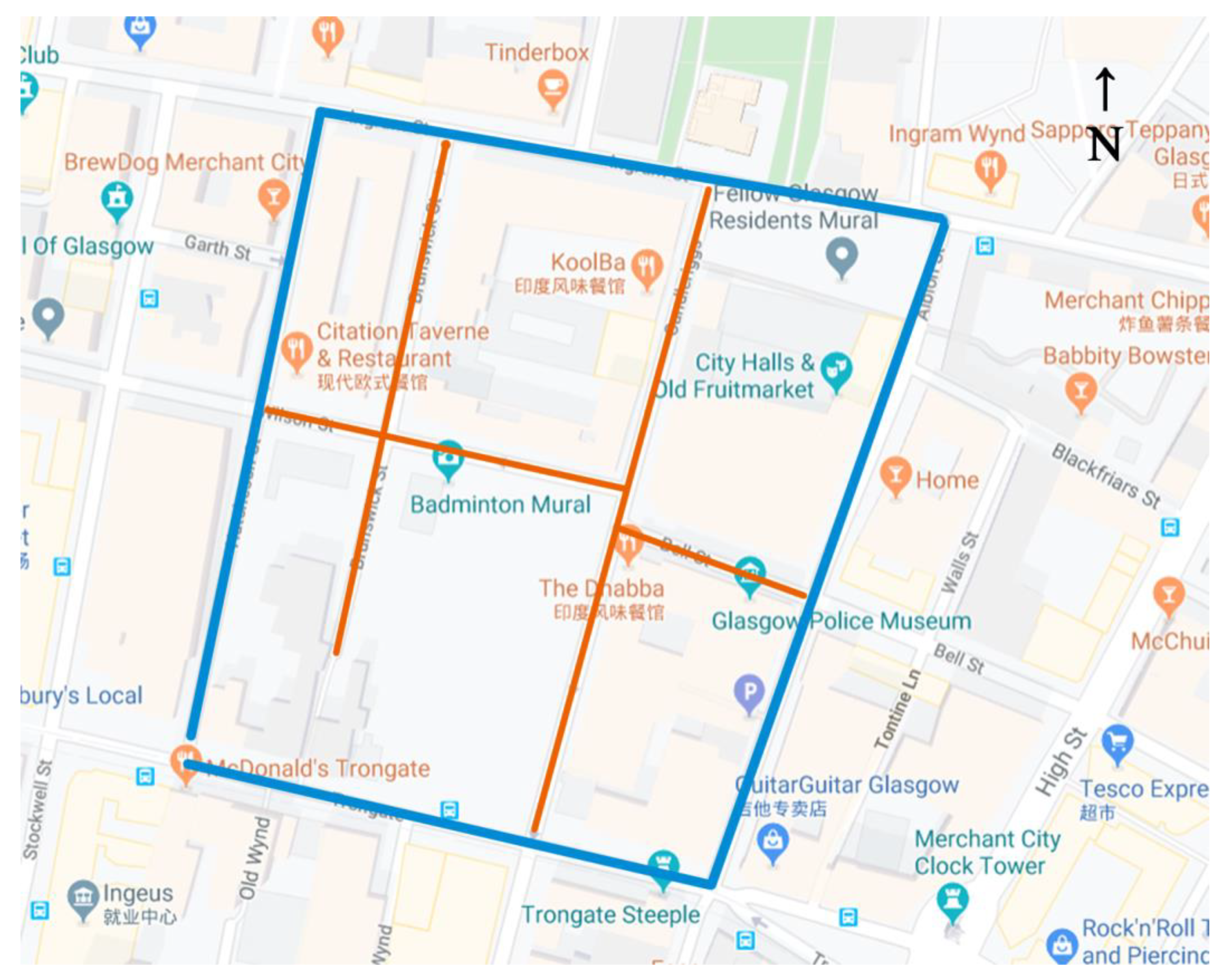
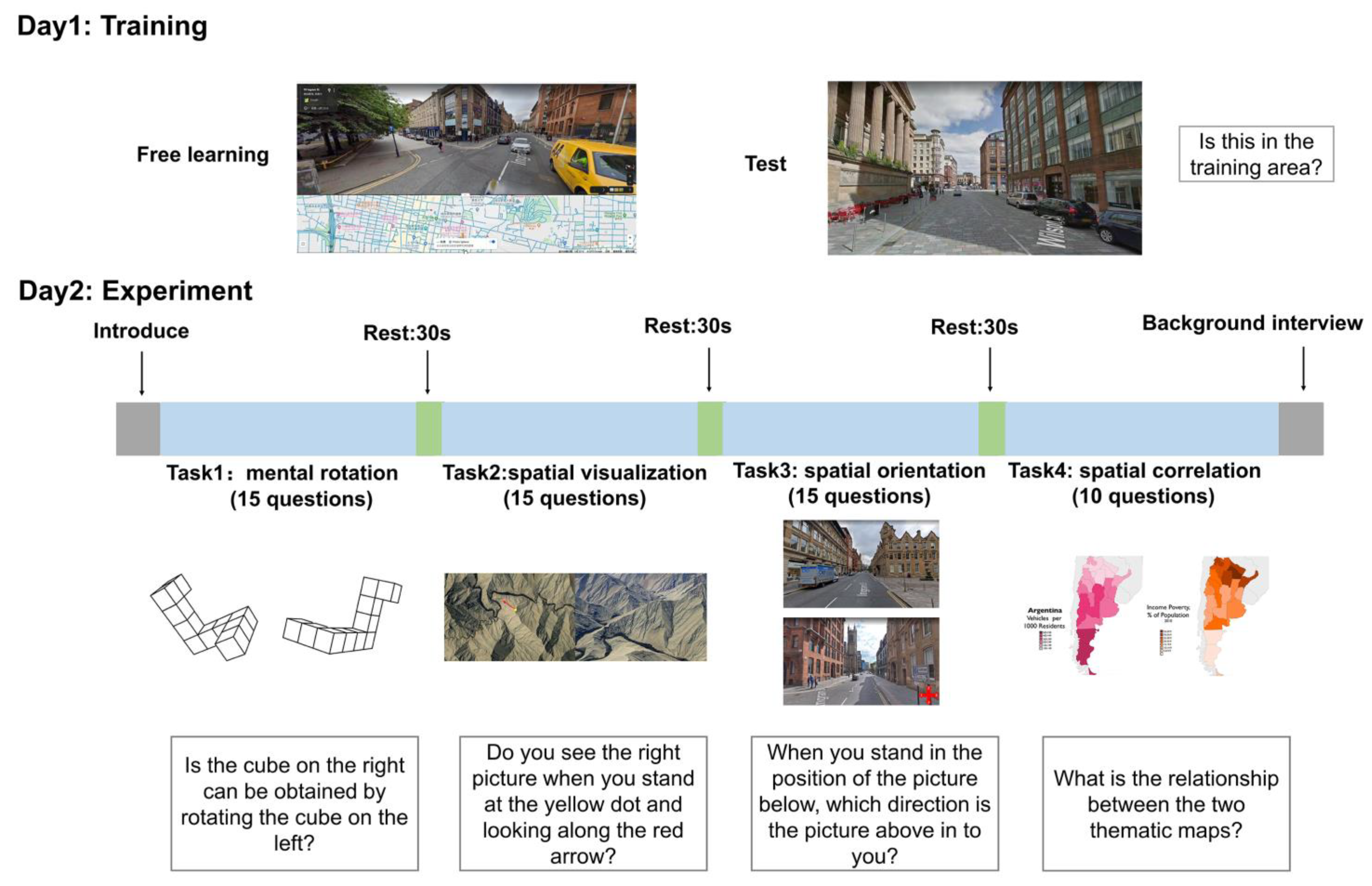
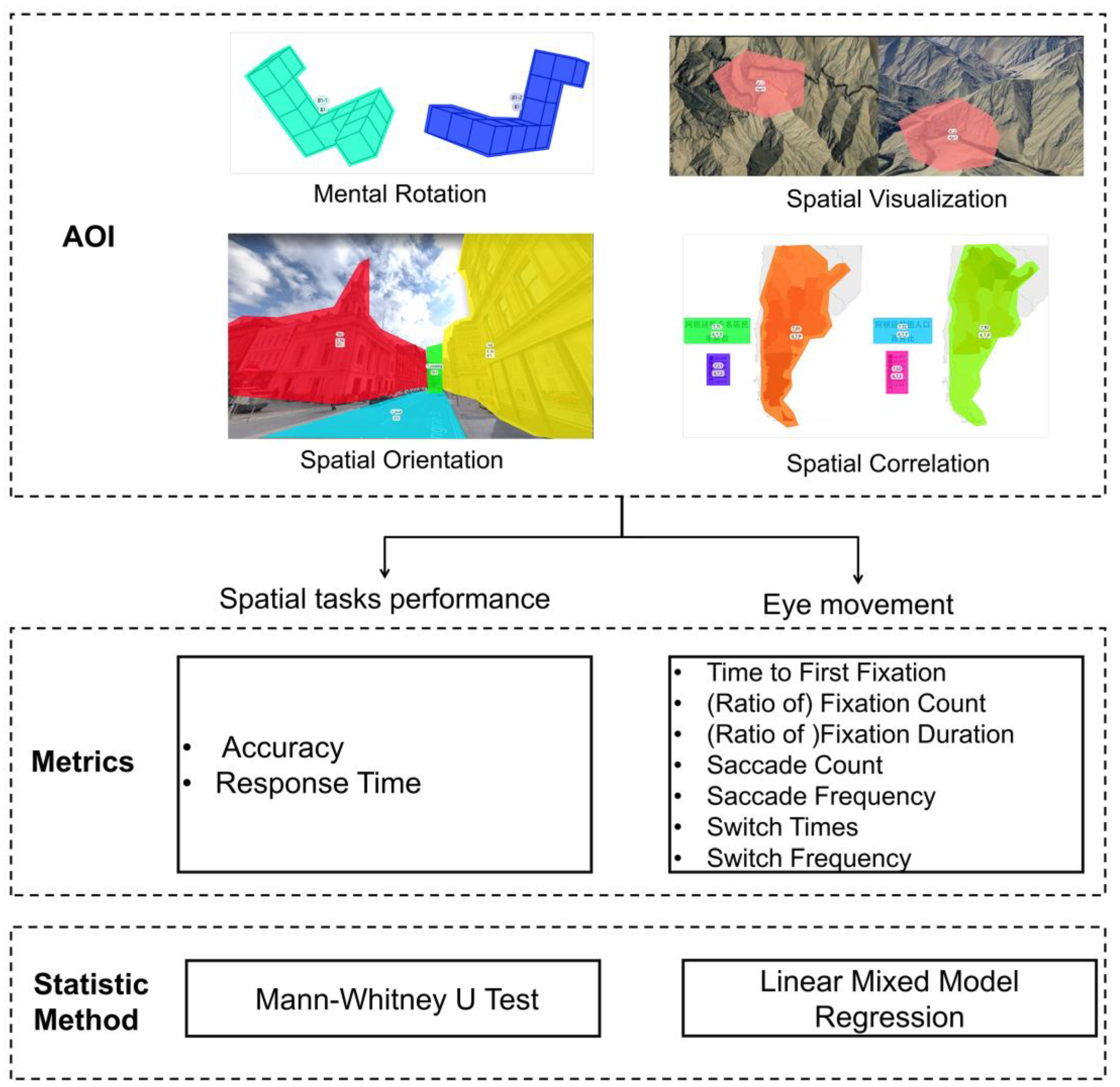
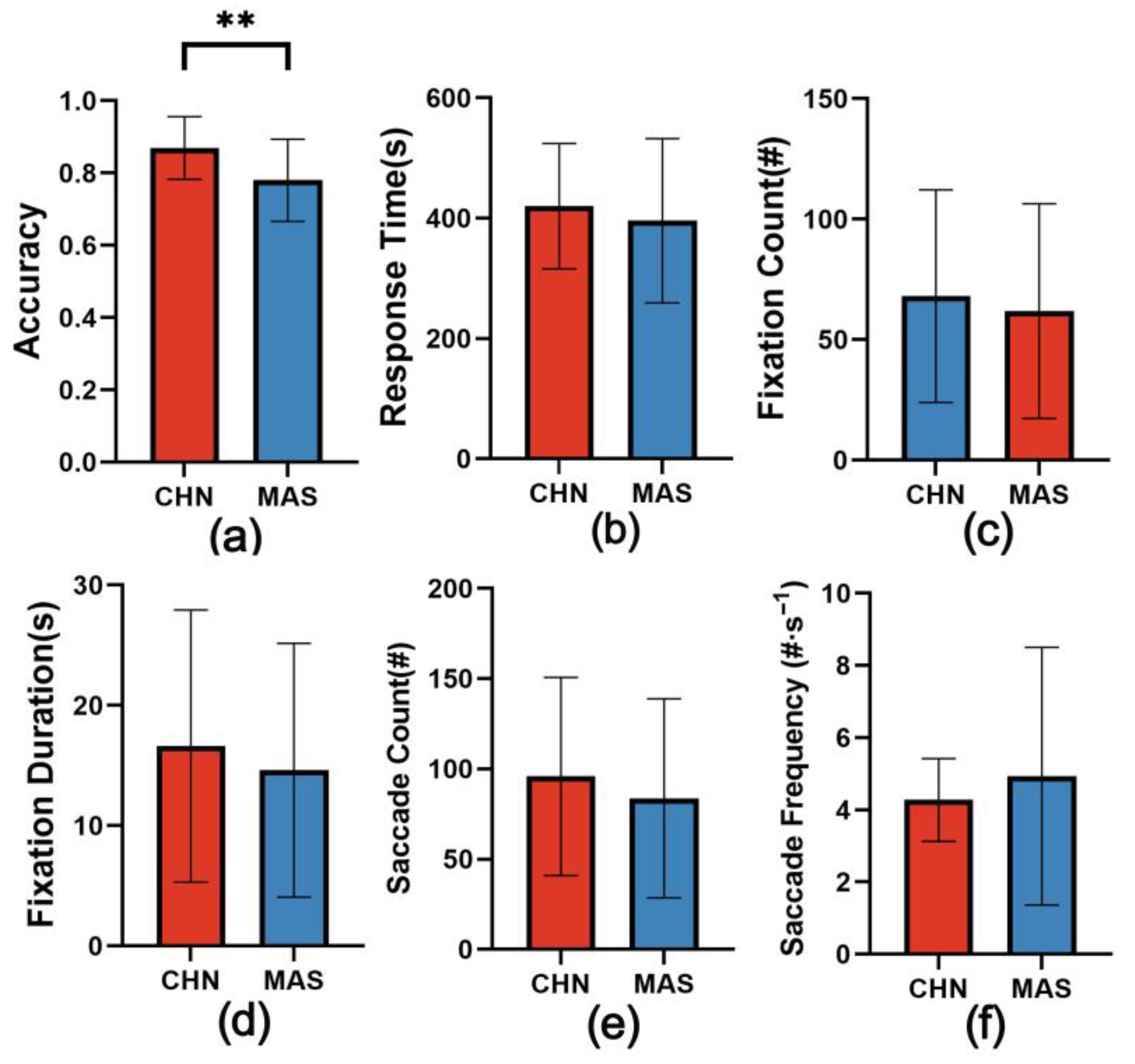
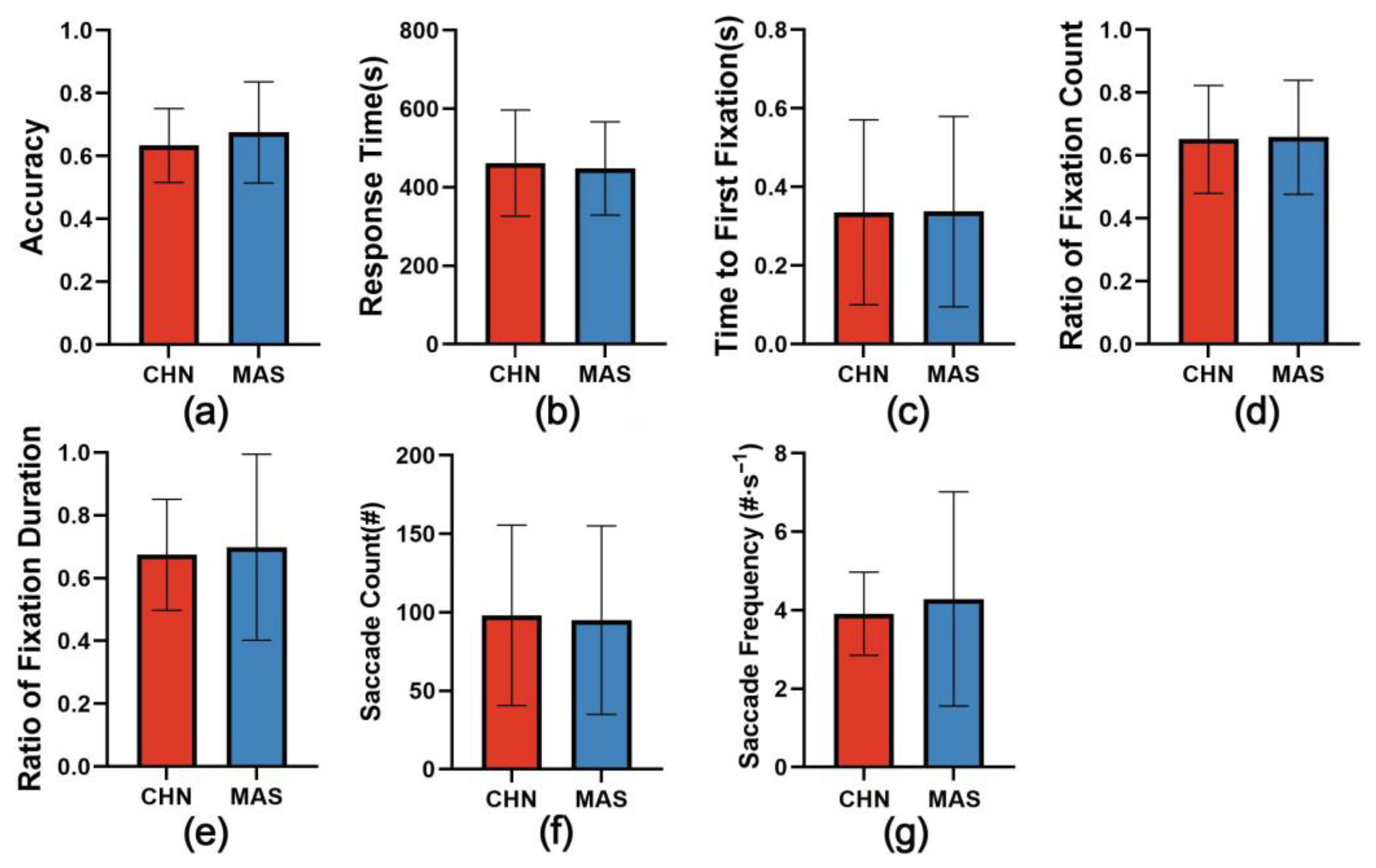
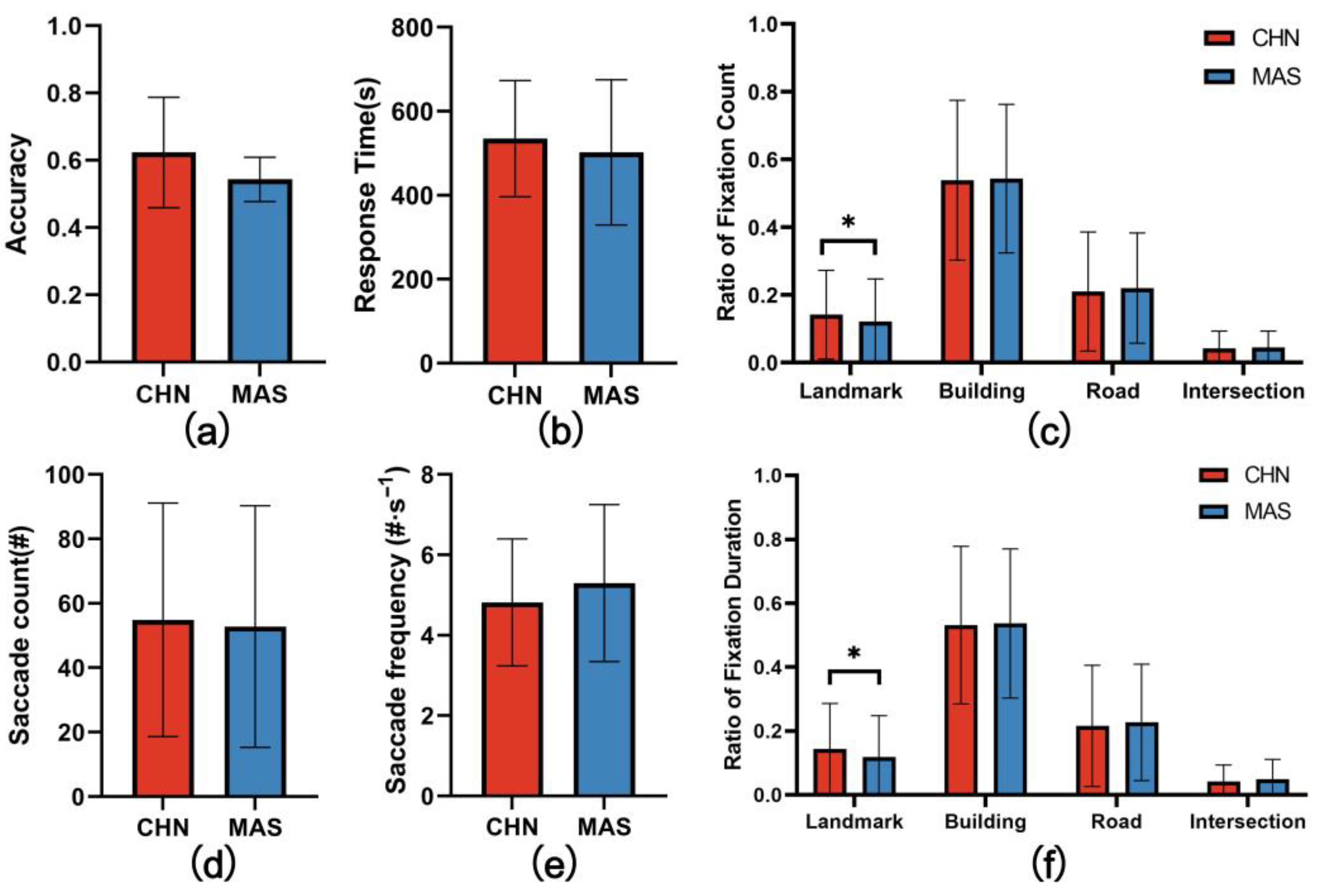
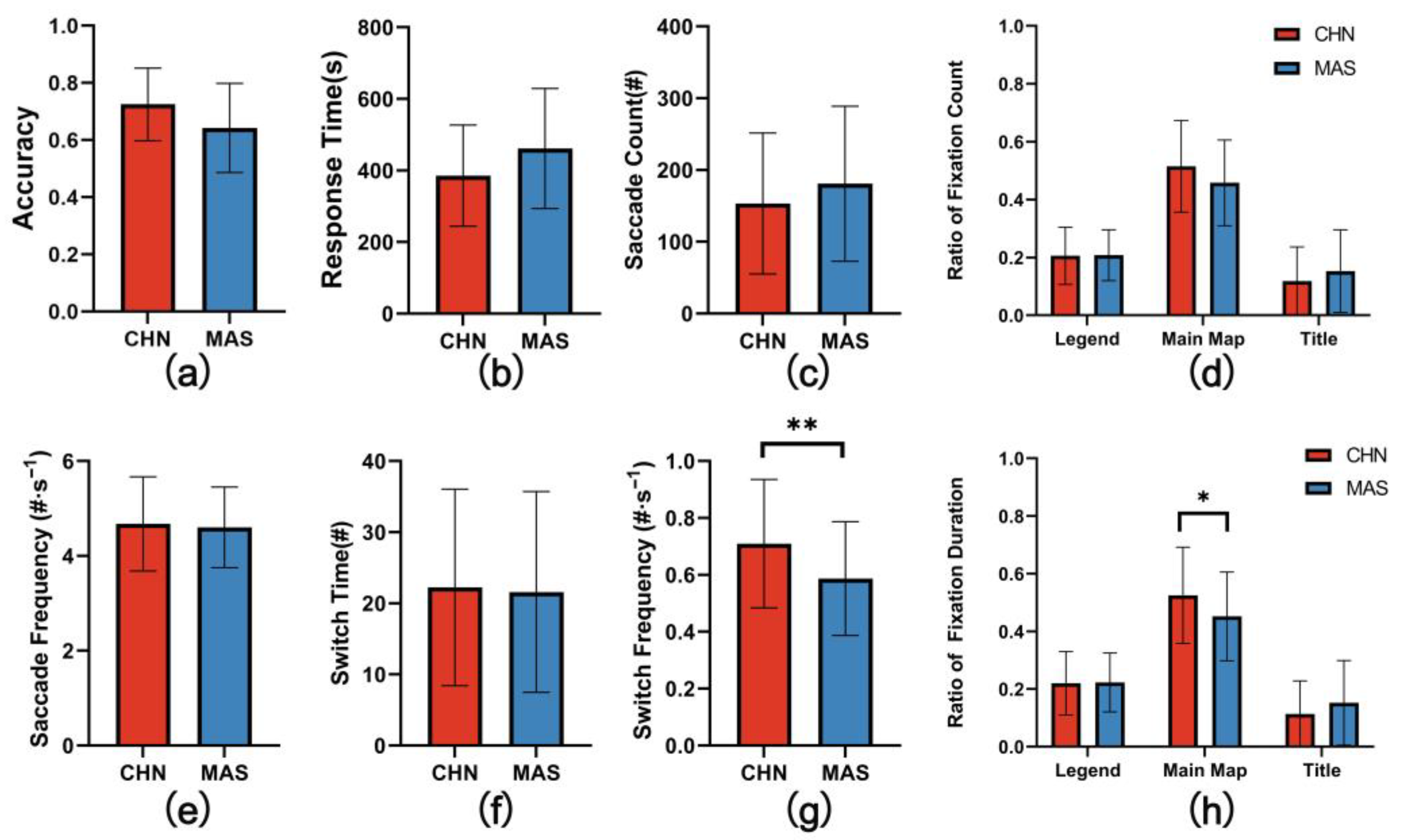
| Evaluation Index | Definition | Meaning |
|---|---|---|
| Accuracy | The ratio of correct answers in the task | The accuracy and efficiency |
| Response Time | The time the participants take to complete a task | |
| Time to First Fixation | The time spent before the AOI was first fixated on | Time required to notice key information areas |
| (Ratio of) Fixation Count | Number of fixations within the AOI (divided by the total fixation count) | Information processing load |
| (Ratio of) Fixation Duration | All durations of fixation on one AOI (divided by the total fixation duration) | Time required to process information |
| Saccade Count | Total saccade count within the AOI | Information searching load |
| Saccade Frequency | Saccade counts divided by visit duration | Information search efficiency |
| Switch Time | Number of switches between different maps | Number of information matches |
| Switch Frequency | Switching time divided by visit duration | Information matching efficiency |
Publisher’s Note: MDPI stays neutral with regard to jurisdictional claims in published maps and institutional affiliations. |
© 2022 by the authors. Licensee MDPI, Basel, Switzerland. This article is an open access article distributed under the terms and conditions of the Creative Commons Attribution (CC BY) license (https://creativecommons.org/licenses/by/4.0/).
Share and Cite
Tian, Y.; Yang, T.; Dong, W. Does Culture Shape Our Spatial Ability? An Investigation Based on Eye Tracking. ISPRS Int. J. Geo-Inf. 2022, 11, 578. https://doi.org/10.3390/ijgi11110578
Tian Y, Yang T, Dong W. Does Culture Shape Our Spatial Ability? An Investigation Based on Eye Tracking. ISPRS International Journal of Geo-Information. 2022; 11(11):578. https://doi.org/10.3390/ijgi11110578
Chicago/Turabian StyleTian, Yuyang, Tianyu Yang, and Weihua Dong. 2022. "Does Culture Shape Our Spatial Ability? An Investigation Based on Eye Tracking" ISPRS International Journal of Geo-Information 11, no. 11: 578. https://doi.org/10.3390/ijgi11110578
APA StyleTian, Y., Yang, T., & Dong, W. (2022). Does Culture Shape Our Spatial Ability? An Investigation Based on Eye Tracking. ISPRS International Journal of Geo-Information, 11(11), 578. https://doi.org/10.3390/ijgi11110578




